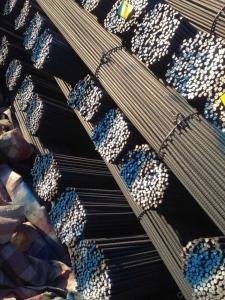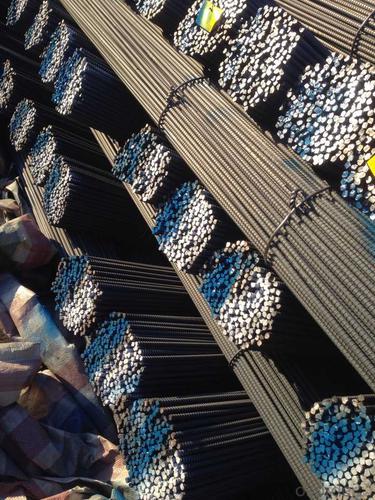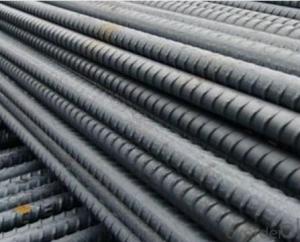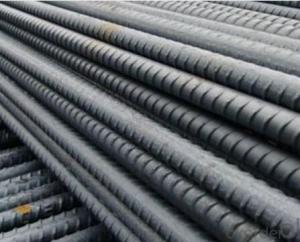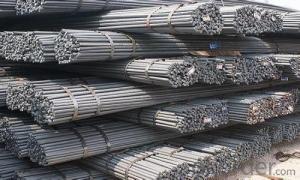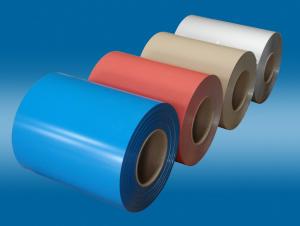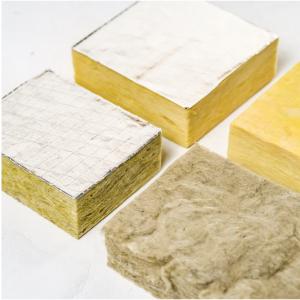Reinforcement Bars - Steel Rebars GB Standard with Variety Sizes
- Loading Port:
- China main port
- Payment Terms:
- TT OR LC
- Min Order Qty:
- 100 m.t.
- Supply Capability:
- 10000 m.t./month
OKorder Service Pledge
OKorder Financial Service
You Might Also Like
Product Description:
OKorder is offering Steel Rebars GB Standard with Variety Sizes at great prices with worldwide shipping. Our supplier is a world-class manufacturer of steel, with our products utilized the world over. OKorder annually supplies products to African, South American and Asian markets. We provide quotations within 24 hours of receiving an inquiry and guarantee competitive prices.
Product Applications:
Steel Rebars GB Standard with Variety Sizes are ideal for structural applications and are widely used in the construction of buildings and bridges, and the manufacturing, petrochemical, and transportation industries.
Product Advantages:
OKorder's Steel Rebars GB Standard with Variety Sizes are durable, strong, and wide variety of sizes.
Main Product Features:
· Premium quality
· Prompt delivery & seaworthy packing (30 days after receiving deposit)
· Can be recycled and reused
· Mill test certification
· Professional Service
· Competitive pricing
Product Specifications:
Manufacture: Hot rolled
Grade: HRB335,HRB400,HRB500
Certificates: ISO, SGS, BV, CIQ
Length: 6m – 12m, as per customer request
Packaging: Export packing, nude packing, bundled
| DEFORMED BAR | |
| SIZE d(mm) | theoretical kg/m |
| 6 | 0.222 |
| 8 | 0.395 |
| 10 | 0.617 |
| 12 | 0.888 |
| 14 | 1.21 |
| 16 | 1.58 |
| 18 | 2 |
| 20 | 2.47 |
| 22 | 2.98 |
| 25 | 3.85 |
| 28 | 4.83 |
| 32 | 6.31 |
FAQ:
Q1: Why buy Materials & Equipment from OKorder.com?
A1: All products offered byOKorder.com are carefully selected from China's most reliable manufacturing enterprises. Through its ISO certifications, OKorder.com adheres to the highest standards and a commitment to supply chain safety and customer satisfaction.
Q2: How many tons of steel products could be loaded in containers?
A2: Usually the steel products are delivered by bulk vessel because of the large quantity and the freight. However, there are no bulk vessel enter some seaports so that we have to deliver the cargo by containers. The 6m steel product can be loaded in 20FT container, but the quantity is changed according to the size, usually from 18tons to 25tons.
Q3: How many tons of steel products could be loaded in containers?
A3: Usually the steel products are delivered by bulk vessel because of the large quantity and the freight. However, there are no bulk vessel enter some seaports so that we have to deliver the cargo by containers. The 6m steel product can be loaded in 20FT container, but the quantity is changed according to the size, usually from 18tons to 25tons.
Images:
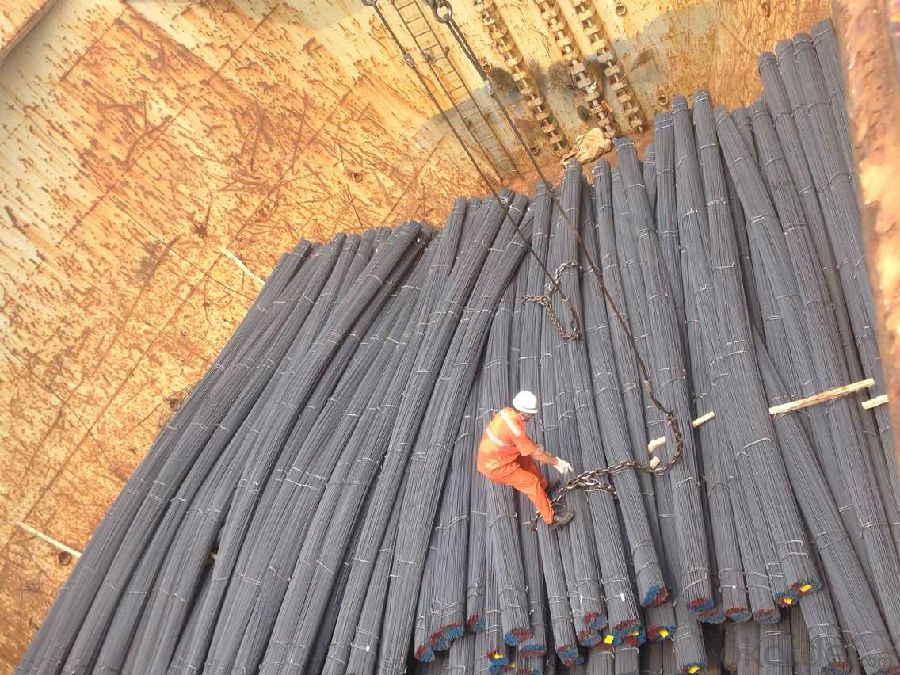
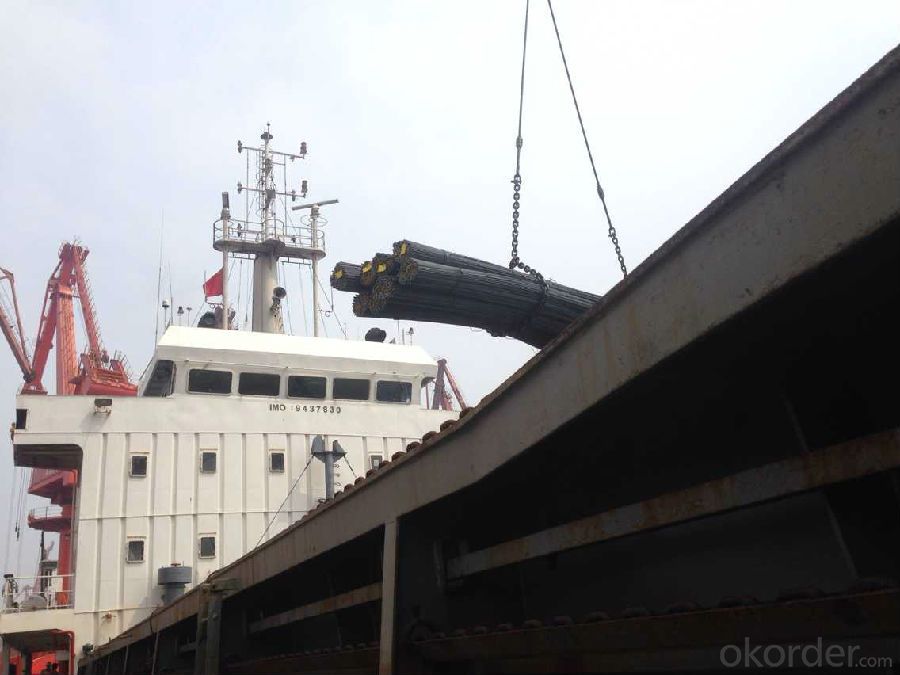
- Q:What is the impact of steel rebars on the overall carbon footprint of a construction project?
- Steel rebars have a significant impact on the overall carbon footprint of a construction project. As a key component in reinforced concrete structures, the production of steel rebars involves high energy consumption and emissions of greenhouse gases, contributing to the project's carbon footprint. However, steel rebars offer durability and strength, reducing the need for frequent repairs or replacements, which can offset their initial carbon emissions over the lifespan of the structure. Additionally, using recycled steel rebars can further minimize the carbon footprint by reducing the energy and emissions associated with the production of new steel.
- Q:Can steel rebars be used in structures with curved or irregular shapes?
- Yes, steel rebars can be used in structures with curved or irregular shapes. The flexibility and malleability of steel allow rebars to be bent and shaped according to the desired design, making it suitable for various architectural and engineering applications.
- Q:What are the common defects or issues associated with steel rebars?
- Common defects or issues associated with steel rebars include: 1. Rust: Steel rebars are prone to rusting when exposed to moisture or corrosive substances. Rust weakens the rebars, reducing their load-bearing capacity and compromising the structural integrity of the reinforced concrete. 2. Poor bonding with concrete: If the rebars are not properly cleaned or have a layer of rust, they may not bond well with the concrete. This can result in reduced strength and durability of the reinforced concrete structure. 3. Improper size or shape: Rebars that are incorrectly sized or shaped can lead to structural issues. For example, rebars that are too short or have inadequate coverage may not provide sufficient reinforcement, making the structure vulnerable to cracking or collapse. 4. Improper placement: Incorrect placement of rebars can lead to weak points in the reinforced concrete. This can occur if rebars are not adequately spaced, not aligned properly, or if there are gaps between the rebar and the concrete. 5. Improper storage and handling: Rebars should be stored in a dry and well-ventilated area to prevent rust. Improper storage or handling can result in surface damage, bending, or twisting of the rebars, affecting their performance in the reinforced concrete. 6. Welding defects: Welded rebars may have defects such as improper fusion, cracks, or lack of penetration, which can compromise the strength and integrity of the reinforcement. 7. Overlapping issues: Overlapping rebars is a common practice to ensure continuity in reinforcement. However, improper overlapping, such as insufficient overlap length or inadequate lapping of rebars, can result in weak joints and reduced structural strength. 8. Quality control issues: Inadequate quality control during the manufacturing or installation process can lead to defects or issues in rebars. This can include issues like improper chemical composition, inadequate strength, or deviations from the specified standards. It is crucial to address and rectify these defects or issues during the design, manufacturing, and construction stages to ensure the safe and reliable performance of reinforced concrete structures. Regular inspection, maintenance, and adherence to industry standards and guidelines are essential to mitigate these common issues associated with steel rebars.
- Q:What are the factors to consider when choosing the right steel rebar for a project?
- When selecting the appropriate steel rebar for a project, several factors need to be taken into consideration. These factors include the type of project, the structural requirements, the environment, and the specific characteristics of the rebar. One of the key factors to consider is the type of project. Different projects, such as residential buildings, bridges, or highways, have varying structural requirements. The steel rebar selected should be able to withstand the anticipated loads and stresses of the project. Additionally, the size and shape of the rebar should also align with the project's design and specifications. Structural requirements play a vital role in choosing the right steel rebar. This includes considering the required tensile strength, yield strength, and elongation properties. It is crucial to select a rebar that can provide the necessary strength and durability to ensure the structural integrity of the project. The environment in which the project will be located is another significant factor. If the project is exposed to corrosive elements, such as saltwater or chemicals, it is important to choose a rebar with corrosion-resistant properties. This can prevent premature deterioration and maintain the longevity of the structure. Furthermore, the specific characteristics of the rebar need to be evaluated. This includes the grade of the steel, which determines its strength and ductility. Different grades, such as ASTM A615 or ASTM A706, have distinct properties that suit various applications. The surface finish of the rebar, such as plain or deformed, also affects its bonding ability with concrete. Other factors that should be taken into account include the availability and cost of the steel rebar. It is crucial to ensure that the selected rebar is readily available and can be obtained in the required quantities and sizes. Additionally, the cost of the rebar should align with the project's budget constraints. In conclusion, when choosing the right steel rebar for a project, it is essential to consider factors such as the type of project, structural requirements, environmental conditions, and specific characteristics of the rebar. By carefully considering these factors, one can select the most suitable steel rebar that ensures the durability and longevity of the structure.
- Q:How are steel rebars measured?
- Steel rebars are typically measured by their diameter and length. The diameter is commonly measured in millimeters or inches, while the length is measured in meters or feet.
- Q:What are the different shapes of steel rebars?
- Steel rebars, also known as reinforcing bars, come in various shapes, including round, square, and deformed. The round rebar is the most common type, while square rebars provide better grip due to their flat sides. Deformed rebars have ridges or indentations, enhancing their bond with concrete and improving structural integrity.
- Q:What is the impact of steel rebars on the overall energy efficiency of a building?
- Steel rebars have a significant impact on the overall energy efficiency of a building. As an integral part of reinforced concrete structures, rebars provide strength and stability to the building, reducing the need for excessive materials and minimizing energy consumption during construction. Additionally, steel rebars help enhance the thermal performance of a building by improving insulation, reducing heat loss, and increasing energy efficiency in heating and cooling operations. Overall, steel rebars contribute to a more sustainable and energy-efficient building design.
- Q:Are there any alternative materials to steel rebars for reinforcement?
- Yes, there are several alternative materials to steel rebars for reinforcement. One such material is fiber-reinforced polymer (FRP) rebars, which are made of high-strength fibers such as carbon, glass, or aramid embedded in a polymer matrix. FRP rebars offer several advantages over steel rebars, including high strength-to-weight ratio, corrosion resistance, and electromagnetic neutrality. They are particularly useful in applications where corrosion is a concern, such as marine environments or structures exposed to chemicals. Another alternative material is basalt rebars, which are made from basalt fiber reinforced with a polymer matrix. Basalt rebars offer similar advantages to FRP rebars, including high strength-to-weight ratio and corrosion resistance. They are also non-conductive and non-magnetic, making them suitable for applications where electromagnetic neutrality is important, such as in MRI facilities or near power lines. In addition to FRP and basalt rebars, other alternative materials for reinforcement include bamboo, timber, and composites made from natural fibers such as hemp or flax. These materials are often used in sustainable construction practices or in regions where they are more readily available than traditional steel rebars. While they may not possess the same strength properties as steel, they can still provide sufficient reinforcement for certain applications and offer other benefits such as low environmental impact or ease of handling and installation. Overall, the availability of alternative materials to steel rebars provides engineers and architects with a range of options to choose from based on the specific requirements of their projects, including factors such as strength, durability, cost, and sustainability.
- Q:The difference between rebar and crescent
- The thread and Crescent are 45 degrees diagonally raised, the thread is straight, crescent shaped arc, like a watermelon rind.
- Q:Can steel rebars be used in foundation repair work?
- Yes, steel rebars can be used in foundation repair work. They are commonly used to reinforce concrete structures, including foundations, to increase their strength and stability. The rebars are embedded within the concrete to provide additional support and prevent the formation of cracks or further damage.
1. Manufacturer Overview |
|
|---|---|
| Location | |
| Year Established | |
| Annual Output Value | |
| Main Markets | |
| Company Certifications | |
2. Manufacturer Certificates |
|
|---|---|
| a) Certification Name | |
| Range | |
| Reference | |
| Validity Period | |
3. Manufacturer Capability |
|
|---|---|
| a)Trade Capacity | |
| Nearest Port | |
| Export Percentage | |
| No.of Employees in Trade Department | |
| Language Spoken: | |
| b)Factory Information | |
| Factory Size: | |
| No. of Production Lines | |
| Contract Manufacturing | |
| Product Price Range | |
Send your message to us
Reinforcement Bars - Steel Rebars GB Standard with Variety Sizes
- Loading Port:
- China main port
- Payment Terms:
- TT OR LC
- Min Order Qty:
- 100 m.t.
- Supply Capability:
- 10000 m.t./month
OKorder Service Pledge
OKorder Financial Service
Similar products
New products
Hot products
Hot Searches
Related keywords
